Assignment | ICT in Education
VerifiedAdded on 2022/09/12
|10
|2315
|25
Assignment
AI Summary
Contribute Materials
Your contribution can guide someone’s learning journey. Share your
documents today.
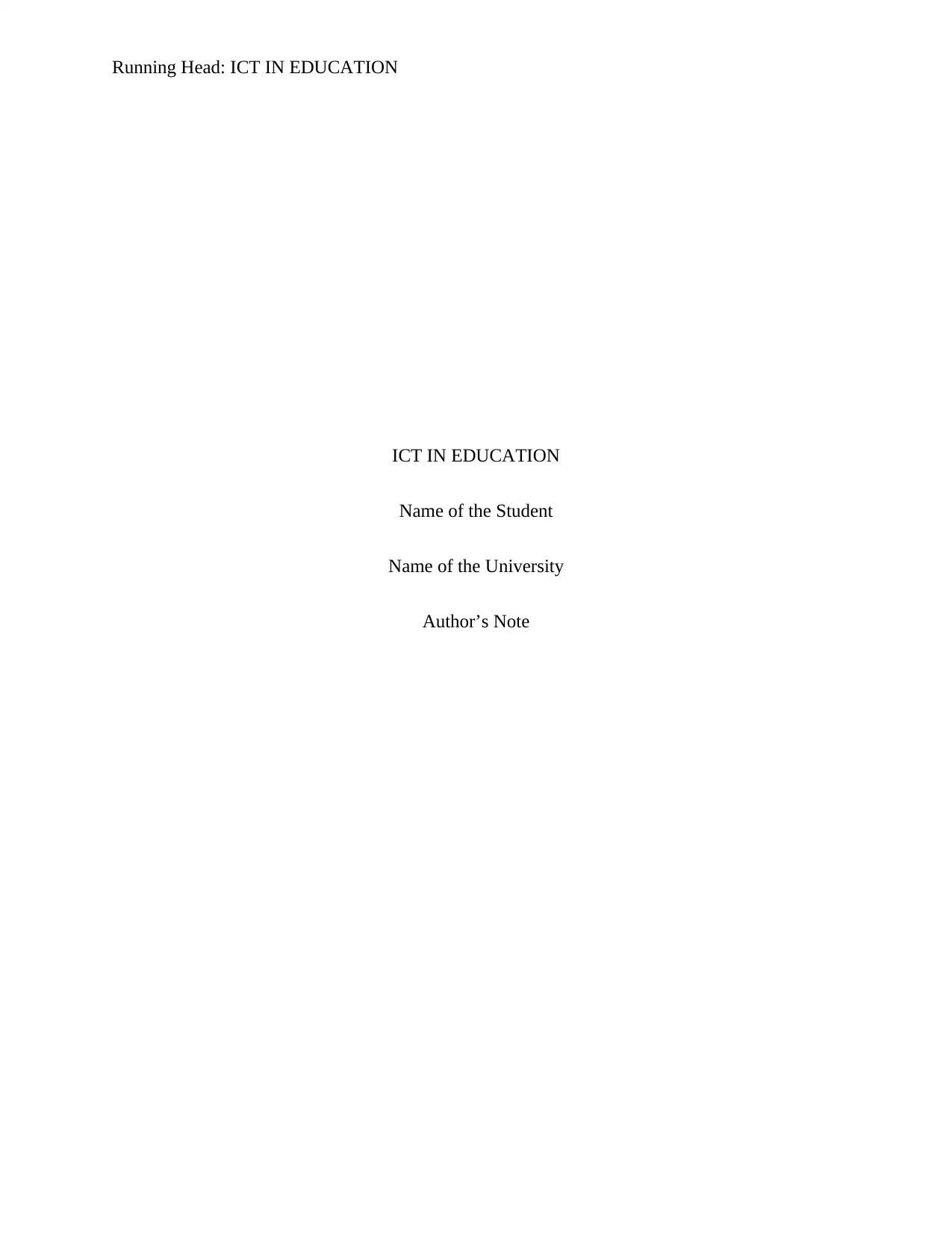
Running Head: ICT IN EDUCATION
ICT IN EDUCATION
Name of the Student
Name of the University
Author’s Note
ICT IN EDUCATION
Name of the Student
Name of the University
Author’s Note
Secure Best Marks with AI Grader
Need help grading? Try our AI Grader for instant feedback on your assignments.
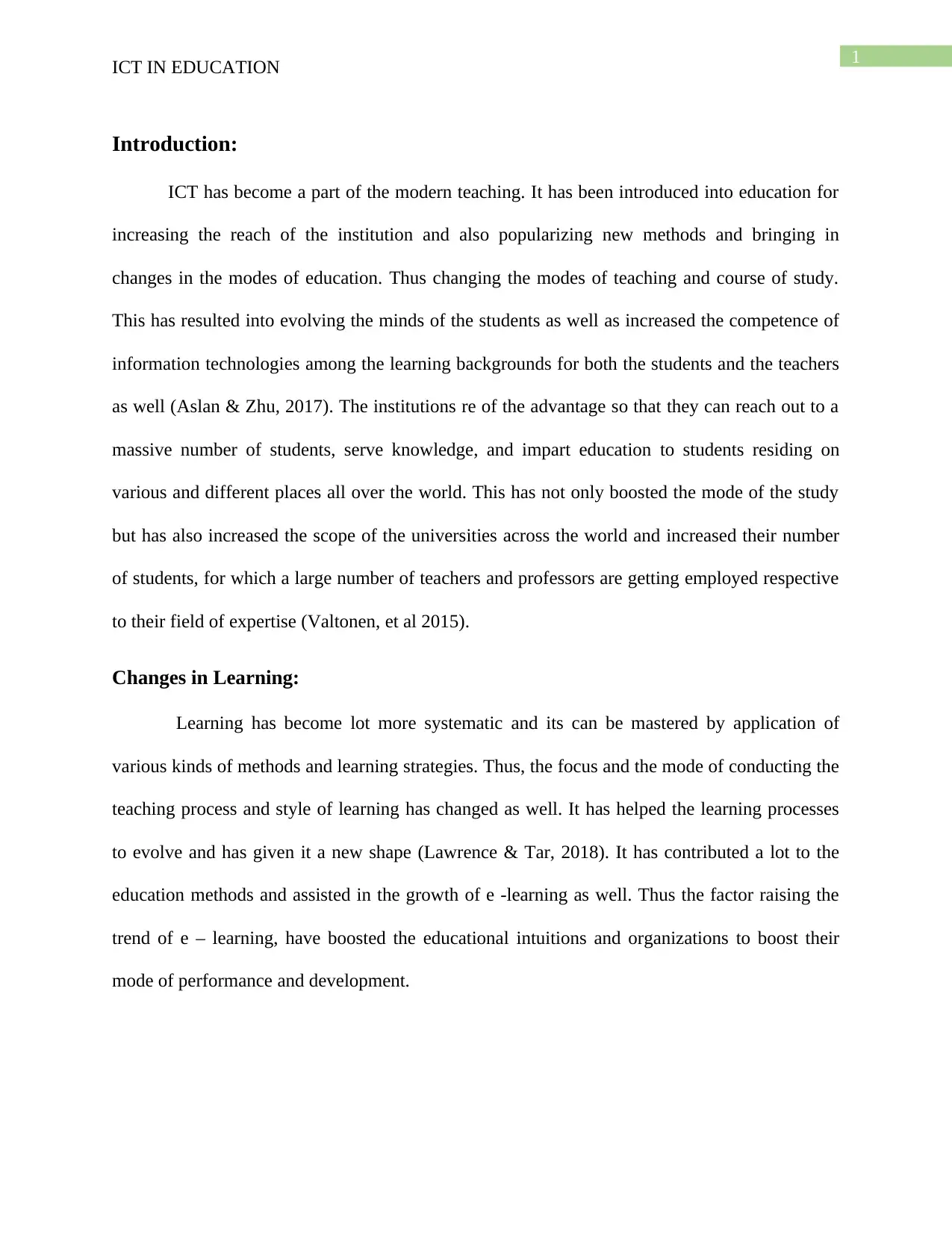
1
ICT IN EDUCATION
Introduction:
ICT has become a part of the modern teaching. It has been introduced into education for
increasing the reach of the institution and also popularizing new methods and bringing in
changes in the modes of education. Thus changing the modes of teaching and course of study.
This has resulted into evolving the minds of the students as well as increased the competence of
information technologies among the learning backgrounds for both the students and the teachers
as well (Aslan & Zhu, 2017). The institutions re of the advantage so that they can reach out to a
massive number of students, serve knowledge, and impart education to students residing on
various and different places all over the world. This has not only boosted the mode of the study
but has also increased the scope of the universities across the world and increased their number
of students, for which a large number of teachers and professors are getting employed respective
to their field of expertise (Valtonen, et al 2015).
Changes in Learning:
Learning has become lot more systematic and its can be mastered by application of
various kinds of methods and learning strategies. Thus, the focus and the mode of conducting the
teaching process and style of learning has changed as well. It has helped the learning processes
to evolve and has given it a new shape (Lawrence & Tar, 2018). It has contributed a lot to the
education methods and assisted in the growth of e -learning as well. Thus the factor raising the
trend of e – learning, have boosted the educational intuitions and organizations to boost their
mode of performance and development.
ICT IN EDUCATION
Introduction:
ICT has become a part of the modern teaching. It has been introduced into education for
increasing the reach of the institution and also popularizing new methods and bringing in
changes in the modes of education. Thus changing the modes of teaching and course of study.
This has resulted into evolving the minds of the students as well as increased the competence of
information technologies among the learning backgrounds for both the students and the teachers
as well (Aslan & Zhu, 2017). The institutions re of the advantage so that they can reach out to a
massive number of students, serve knowledge, and impart education to students residing on
various and different places all over the world. This has not only boosted the mode of the study
but has also increased the scope of the universities across the world and increased their number
of students, for which a large number of teachers and professors are getting employed respective
to their field of expertise (Valtonen, et al 2015).
Changes in Learning:
Learning has become lot more systematic and its can be mastered by application of
various kinds of methods and learning strategies. Thus, the focus and the mode of conducting the
teaching process and style of learning has changed as well. It has helped the learning processes
to evolve and has given it a new shape (Lawrence & Tar, 2018). It has contributed a lot to the
education methods and assisted in the growth of e -learning as well. Thus the factor raising the
trend of e – learning, have boosted the educational intuitions and organizations to boost their
mode of performance and development.
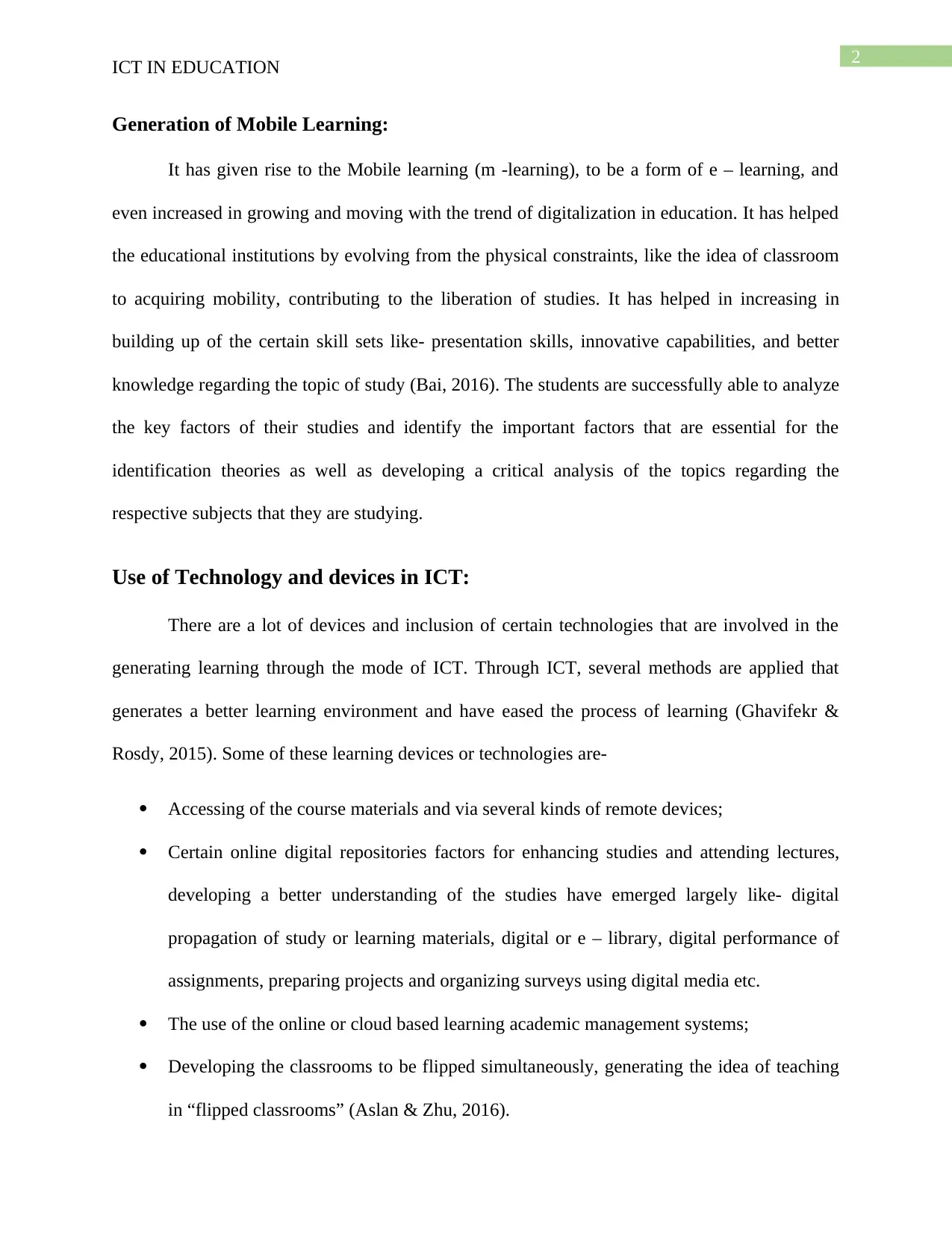
2
ICT IN EDUCATION
Generation of Mobile Learning:
It has given rise to the Mobile learning (m ‐learning), to be a form of e – learning, and
even increased in growing and moving with the trend of digitalization in education. It has helped
the educational institutions by evolving from the physical constraints, like the idea of classroom
to acquiring mobility, contributing to the liberation of studies. It has helped in increasing in
building up of the certain skill sets like- presentation skills, innovative capabilities, and better
knowledge regarding the topic of study (Bai, 2016). The students are successfully able to analyze
the key factors of their studies and identify the important factors that are essential for the
identification theories as well as developing a critical analysis of the topics regarding the
respective subjects that they are studying.
Use of Technology and devices in ICT:
There are a lot of devices and inclusion of certain technologies that are involved in the
generating learning through the mode of ICT. Through ICT, several methods are applied that
generates a better learning environment and have eased the process of learning (Ghavifekr &
Rosdy, 2015). Some of these learning devices or technologies are-
Accessing of the course materials and via several kinds of remote devices;
Certain online digital repositories factors for enhancing studies and attending lectures,
developing a better understanding of the studies have emerged largely like- digital
propagation of study or learning materials, digital or e – library, digital performance of
assignments, preparing projects and organizing surveys using digital media etc.
The use of the online or cloud based learning academic management systems;
Developing the classrooms to be flipped simultaneously, generating the idea of teaching
in “flipped classrooms” (Aslan & Zhu, 2016).
ICT IN EDUCATION
Generation of Mobile Learning:
It has given rise to the Mobile learning (m ‐learning), to be a form of e – learning, and
even increased in growing and moving with the trend of digitalization in education. It has helped
the educational institutions by evolving from the physical constraints, like the idea of classroom
to acquiring mobility, contributing to the liberation of studies. It has helped in increasing in
building up of the certain skill sets like- presentation skills, innovative capabilities, and better
knowledge regarding the topic of study (Bai, 2016). The students are successfully able to analyze
the key factors of their studies and identify the important factors that are essential for the
identification theories as well as developing a critical analysis of the topics regarding the
respective subjects that they are studying.
Use of Technology and devices in ICT:
There are a lot of devices and inclusion of certain technologies that are involved in the
generating learning through the mode of ICT. Through ICT, several methods are applied that
generates a better learning environment and have eased the process of learning (Ghavifekr &
Rosdy, 2015). Some of these learning devices or technologies are-
Accessing of the course materials and via several kinds of remote devices;
Certain online digital repositories factors for enhancing studies and attending lectures,
developing a better understanding of the studies have emerged largely like- digital
propagation of study or learning materials, digital or e – library, digital performance of
assignments, preparing projects and organizing surveys using digital media etc.
The use of the online or cloud based learning academic management systems;
Developing the classrooms to be flipped simultaneously, generating the idea of teaching
in “flipped classrooms” (Aslan & Zhu, 2016).
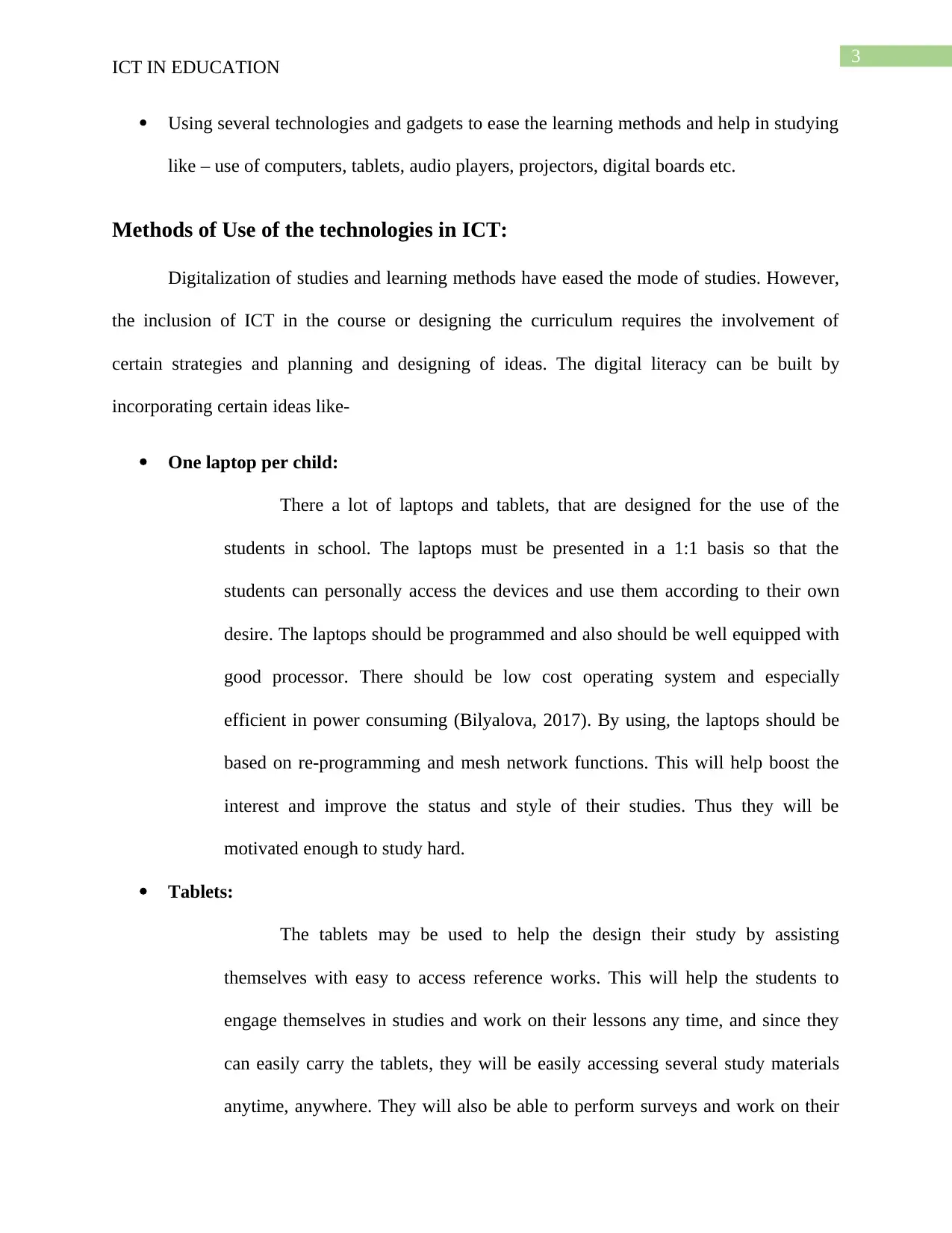
3
ICT IN EDUCATION
Using several technologies and gadgets to ease the learning methods and help in studying
like – use of computers, tablets, audio players, projectors, digital boards etc.
Methods of Use of the technologies in ICT:
Digitalization of studies and learning methods have eased the mode of studies. However,
the inclusion of ICT in the course or designing the curriculum requires the involvement of
certain strategies and planning and designing of ideas. The digital literacy can be built by
incorporating certain ideas like-
One laptop per child:
There a lot of laptops and tablets, that are designed for the use of the
students in school. The laptops must be presented in a 1:1 basis so that the
students can personally access the devices and use them according to their own
desire. The laptops should be programmed and also should be well equipped with
good processor. There should be low cost operating system and especially
efficient in power consuming (Bilyalova, 2017). By using, the laptops should be
based on re-programming and mesh network functions. This will help boost the
interest and improve the status and style of their studies. Thus they will be
motivated enough to study hard.
Tablets:
The tablets may be used to help the design their study by assisting
themselves with easy to access reference works. This will help the students to
engage themselves in studies and work on their lessons any time, and since they
can easily carry the tablets, they will be easily accessing several study materials
anytime, anywhere. They will also be able to perform surveys and work on their
ICT IN EDUCATION
Using several technologies and gadgets to ease the learning methods and help in studying
like – use of computers, tablets, audio players, projectors, digital boards etc.
Methods of Use of the technologies in ICT:
Digitalization of studies and learning methods have eased the mode of studies. However,
the inclusion of ICT in the course or designing the curriculum requires the involvement of
certain strategies and planning and designing of ideas. The digital literacy can be built by
incorporating certain ideas like-
One laptop per child:
There a lot of laptops and tablets, that are designed for the use of the
students in school. The laptops must be presented in a 1:1 basis so that the
students can personally access the devices and use them according to their own
desire. The laptops should be programmed and also should be well equipped with
good processor. There should be low cost operating system and especially
efficient in power consuming (Bilyalova, 2017). By using, the laptops should be
based on re-programming and mesh network functions. This will help boost the
interest and improve the status and style of their studies. Thus they will be
motivated enough to study hard.
Tablets:
The tablets may be used to help the design their study by assisting
themselves with easy to access reference works. This will help the students to
engage themselves in studies and work on their lessons any time, and since they
can easily carry the tablets, they will be easily accessing several study materials
anytime, anywhere. They will also be able to perform surveys and work on their
Secure Best Marks with AI Grader
Need help grading? Try our AI Grader for instant feedback on your assignments.
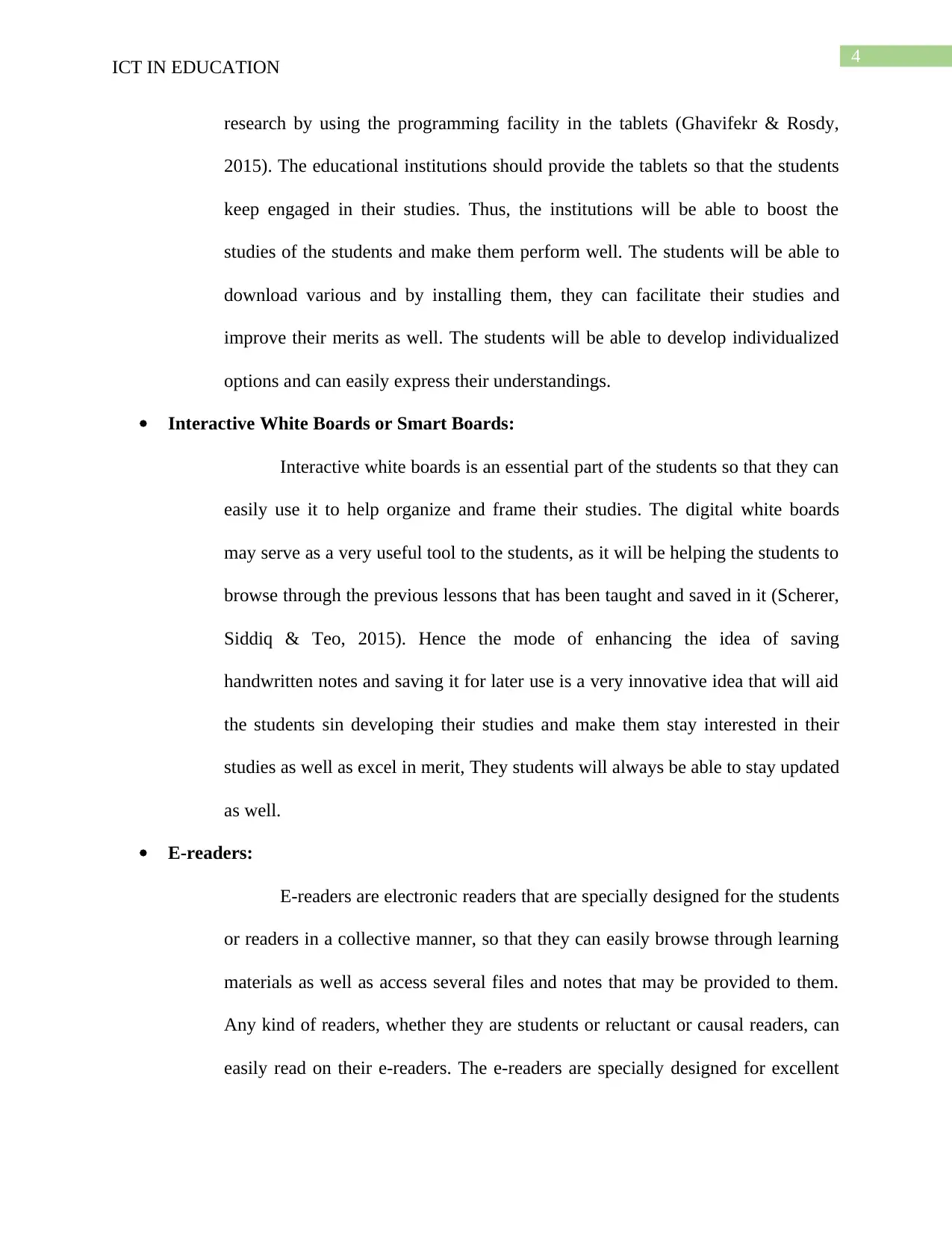
4
ICT IN EDUCATION
research by using the programming facility in the tablets (Ghavifekr & Rosdy,
2015). The educational institutions should provide the tablets so that the students
keep engaged in their studies. Thus, the institutions will be able to boost the
studies of the students and make them perform well. The students will be able to
download various and by installing them, they can facilitate their studies and
improve their merits as well. The students will be able to develop individualized
options and can easily express their understandings.
Interactive White Boards or Smart Boards:
Interactive white boards is an essential part of the students so that they can
easily use it to help organize and frame their studies. The digital white boards
may serve as a very useful tool to the students, as it will be helping the students to
browse through the previous lessons that has been taught and saved in it (Scherer,
Siddiq & Teo, 2015). Hence the mode of enhancing the idea of saving
handwritten notes and saving it for later use is a very innovative idea that will aid
the students sin developing their studies and make them stay interested in their
studies as well as excel in merit, They students will always be able to stay updated
as well.
E-readers:
E-readers are electronic readers that are specially designed for the students
or readers in a collective manner, so that they can easily browse through learning
materials as well as access several files and notes that may be provided to them.
Any kind of readers, whether they are students or reluctant or causal readers, can
easily read on their e-readers. The e-readers are specially designed for excellent
ICT IN EDUCATION
research by using the programming facility in the tablets (Ghavifekr & Rosdy,
2015). The educational institutions should provide the tablets so that the students
keep engaged in their studies. Thus, the institutions will be able to boost the
studies of the students and make them perform well. The students will be able to
download various and by installing them, they can facilitate their studies and
improve their merits as well. The students will be able to develop individualized
options and can easily express their understandings.
Interactive White Boards or Smart Boards:
Interactive white boards is an essential part of the students so that they can
easily use it to help organize and frame their studies. The digital white boards
may serve as a very useful tool to the students, as it will be helping the students to
browse through the previous lessons that has been taught and saved in it (Scherer,
Siddiq & Teo, 2015). Hence the mode of enhancing the idea of saving
handwritten notes and saving it for later use is a very innovative idea that will aid
the students sin developing their studies and make them stay interested in their
studies as well as excel in merit, They students will always be able to stay updated
as well.
E-readers:
E-readers are electronic readers that are specially designed for the students
or readers in a collective manner, so that they can easily browse through learning
materials as well as access several files and notes that may be provided to them.
Any kind of readers, whether they are students or reluctant or causal readers, can
easily read on their e-readers. The e-readers are specially designed for excellent
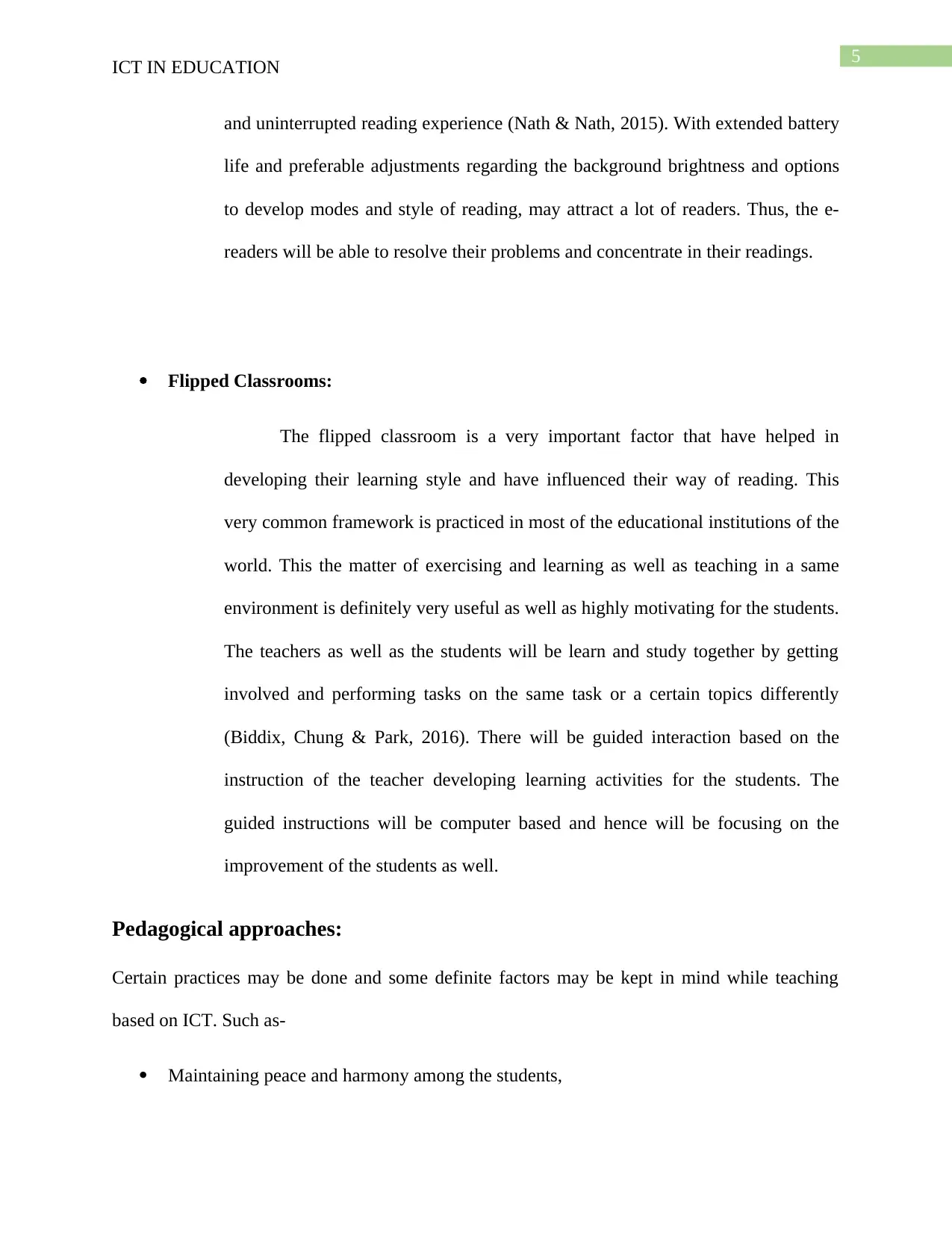
5
ICT IN EDUCATION
and uninterrupted reading experience (Nath & Nath, 2015). With extended battery
life and preferable adjustments regarding the background brightness and options
to develop modes and style of reading, may attract a lot of readers. Thus, the e-
readers will be able to resolve their problems and concentrate in their readings.
Flipped Classrooms:
The flipped classroom is a very important factor that have helped in
developing their learning style and have influenced their way of reading. This
very common framework is practiced in most of the educational institutions of the
world. This the matter of exercising and learning as well as teaching in a same
environment is definitely very useful as well as highly motivating for the students.
The teachers as well as the students will be learn and study together by getting
involved and performing tasks on the same task or a certain topics differently
(Biddix, Chung & Park, 2016). There will be guided interaction based on the
instruction of the teacher developing learning activities for the students. The
guided instructions will be computer based and hence will be focusing on the
improvement of the students as well.
Pedagogical approaches:
Certain practices may be done and some definite factors may be kept in mind while teaching
based on ICT. Such as-
Maintaining peace and harmony among the students,
ICT IN EDUCATION
and uninterrupted reading experience (Nath & Nath, 2015). With extended battery
life and preferable adjustments regarding the background brightness and options
to develop modes and style of reading, may attract a lot of readers. Thus, the e-
readers will be able to resolve their problems and concentrate in their readings.
Flipped Classrooms:
The flipped classroom is a very important factor that have helped in
developing their learning style and have influenced their way of reading. This
very common framework is practiced in most of the educational institutions of the
world. This the matter of exercising and learning as well as teaching in a same
environment is definitely very useful as well as highly motivating for the students.
The teachers as well as the students will be learn and study together by getting
involved and performing tasks on the same task or a certain topics differently
(Biddix, Chung & Park, 2016). There will be guided interaction based on the
instruction of the teacher developing learning activities for the students. The
guided instructions will be computer based and hence will be focusing on the
improvement of the students as well.
Pedagogical approaches:
Certain practices may be done and some definite factors may be kept in mind while teaching
based on ICT. Such as-
Maintaining peace and harmony among the students,
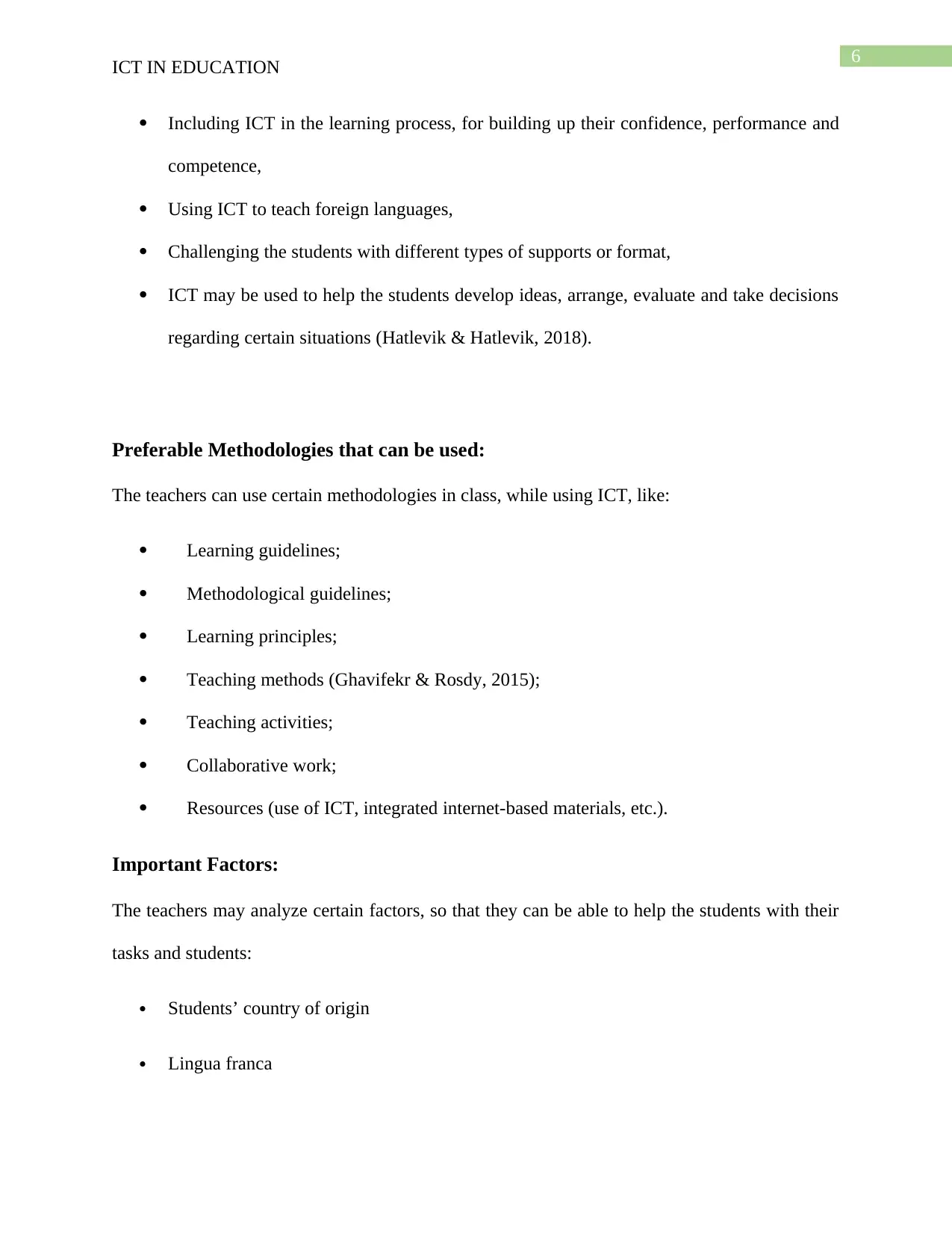
6
ICT IN EDUCATION
Including ICT in the learning process, for building up their confidence, performance and
competence,
Using ICT to teach foreign languages,
Challenging the students with different types of supports or format,
ICT may be used to help the students develop ideas, arrange, evaluate and take decisions
regarding certain situations (Hatlevik & Hatlevik, 2018).
Preferable Methodologies that can be used:
The teachers can use certain methodologies in class, while using ICT, like:
Learning guidelines;
Methodological guidelines;
Learning principles;
Teaching methods (Ghavifekr & Rosdy, 2015);
Teaching activities;
Collaborative work;
Resources (use of ICT, integrated internet-based materials, etc.).
Important Factors:
The teachers may analyze certain factors, so that they can be able to help the students with their
tasks and students:
Students’ country of origin
Lingua franca
ICT IN EDUCATION
Including ICT in the learning process, for building up their confidence, performance and
competence,
Using ICT to teach foreign languages,
Challenging the students with different types of supports or format,
ICT may be used to help the students develop ideas, arrange, evaluate and take decisions
regarding certain situations (Hatlevik & Hatlevik, 2018).
Preferable Methodologies that can be used:
The teachers can use certain methodologies in class, while using ICT, like:
Learning guidelines;
Methodological guidelines;
Learning principles;
Teaching methods (Ghavifekr & Rosdy, 2015);
Teaching activities;
Collaborative work;
Resources (use of ICT, integrated internet-based materials, etc.).
Important Factors:
The teachers may analyze certain factors, so that they can be able to help the students with their
tasks and students:
Students’ country of origin
Lingua franca
Paraphrase This Document
Need a fresh take? Get an instant paraphrase of this document with our AI Paraphraser
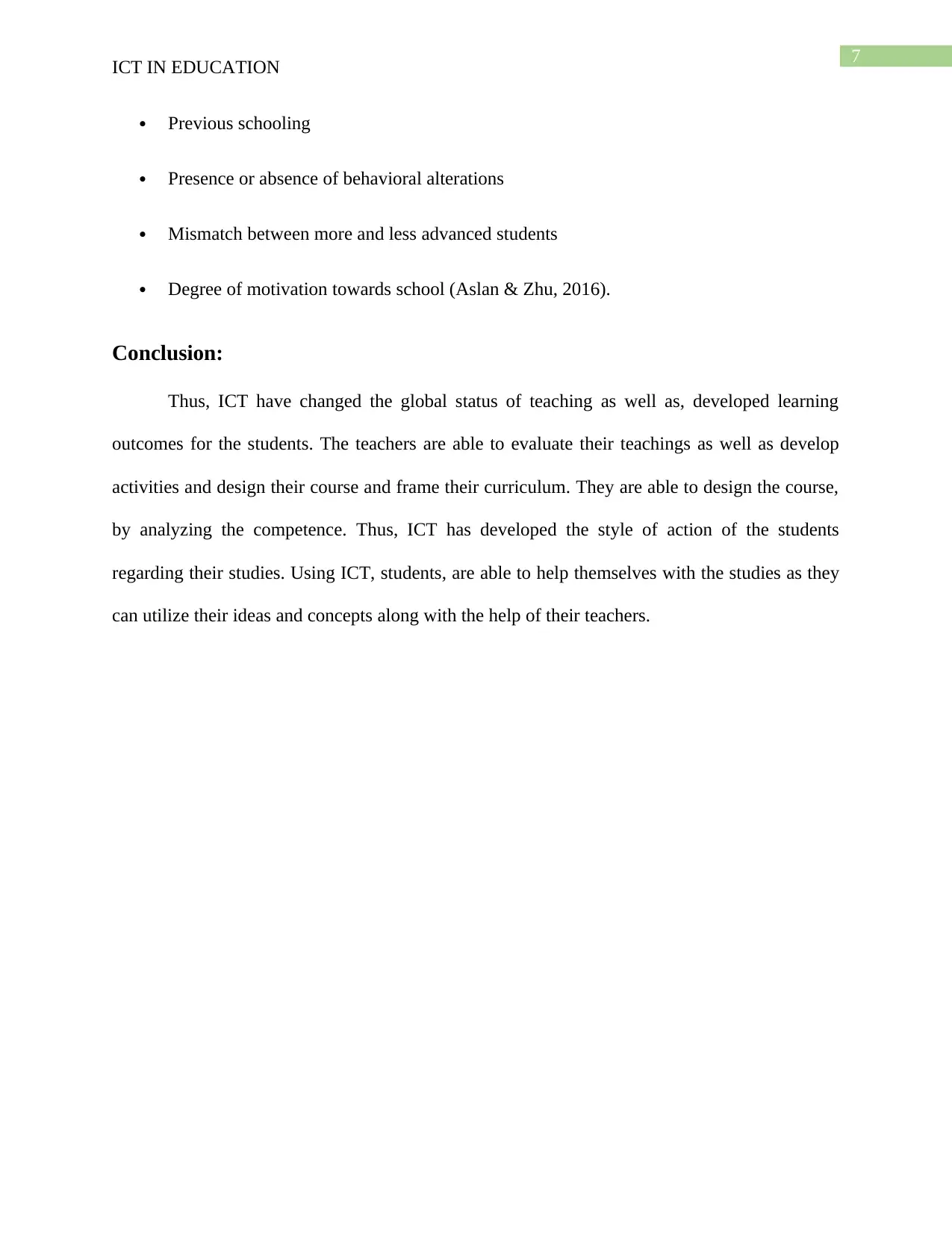
7
ICT IN EDUCATION
Previous schooling
Presence or absence of behavioral alterations
Mismatch between more and less advanced students
Degree of motivation towards school (Aslan & Zhu, 2016).
Conclusion:
Thus, ICT have changed the global status of teaching as well as, developed learning
outcomes for the students. The teachers are able to evaluate their teachings as well as develop
activities and design their course and frame their curriculum. They are able to design the course,
by analyzing the competence. Thus, ICT has developed the style of action of the students
regarding their studies. Using ICT, students, are able to help themselves with the studies as they
can utilize their ideas and concepts along with the help of their teachers.
ICT IN EDUCATION
Previous schooling
Presence or absence of behavioral alterations
Mismatch between more and less advanced students
Degree of motivation towards school (Aslan & Zhu, 2016).
Conclusion:
Thus, ICT have changed the global status of teaching as well as, developed learning
outcomes for the students. The teachers are able to evaluate their teachings as well as develop
activities and design their course and frame their curriculum. They are able to design the course,
by analyzing the competence. Thus, ICT has developed the style of action of the students
regarding their studies. Using ICT, students, are able to help themselves with the studies as they
can utilize their ideas and concepts along with the help of their teachers.
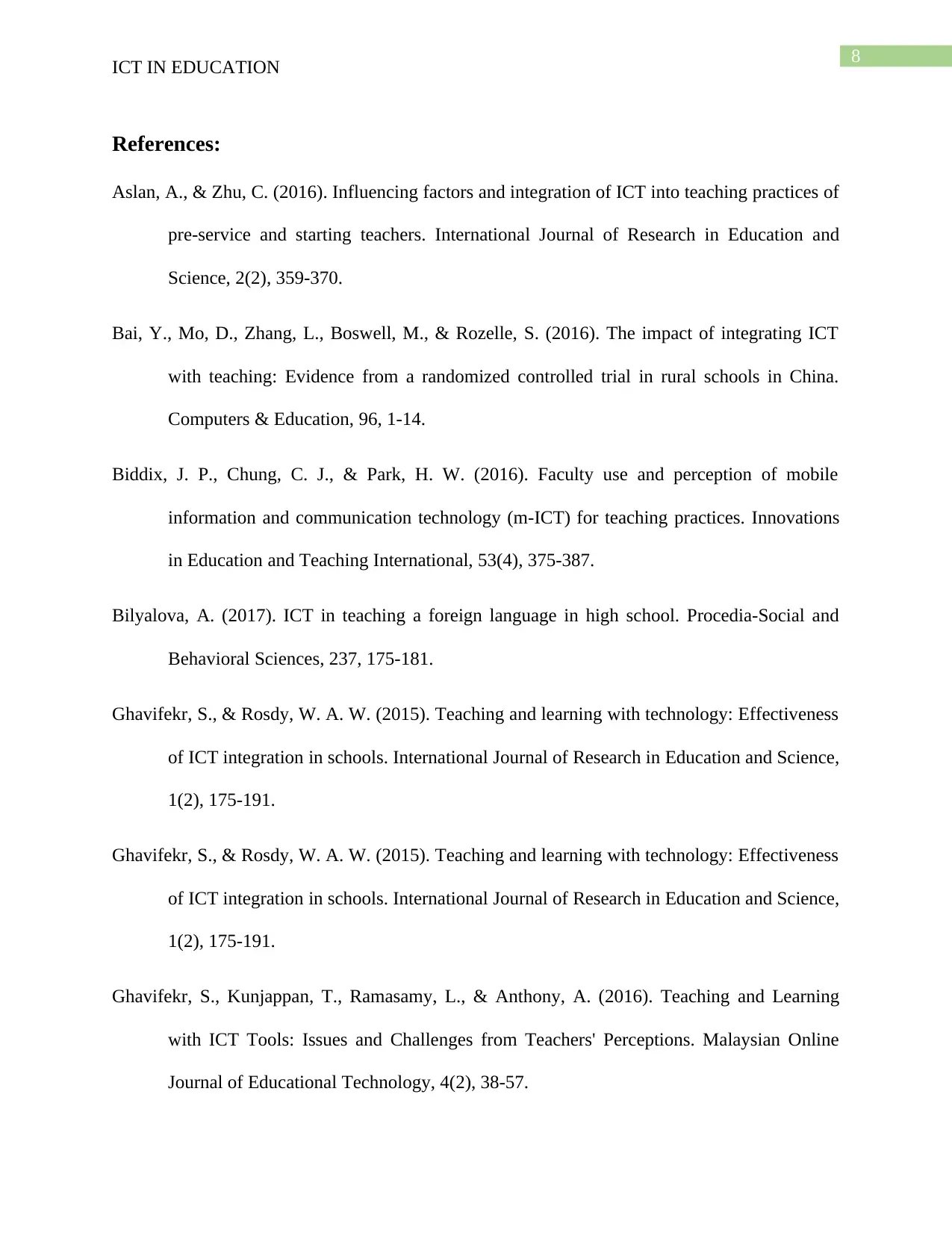
8
ICT IN EDUCATION
References:
Aslan, A., & Zhu, C. (2016). Influencing factors and integration of ICT into teaching practices of
pre-service and starting teachers. International Journal of Research in Education and
Science, 2(2), 359-370.
Bai, Y., Mo, D., Zhang, L., Boswell, M., & Rozelle, S. (2016). The impact of integrating ICT
with teaching: Evidence from a randomized controlled trial in rural schools in China.
Computers & Education, 96, 1-14.
Biddix, J. P., Chung, C. J., & Park, H. W. (2016). Faculty use and perception of mobile
information and communication technology (m-ICT) for teaching practices. Innovations
in Education and Teaching International, 53(4), 375-387.
Bilyalova, A. (2017). ICT in teaching a foreign language in high school. Procedia-Social and
Behavioral Sciences, 237, 175-181.
Ghavifekr, S., & Rosdy, W. A. W. (2015). Teaching and learning with technology: Effectiveness
of ICT integration in schools. International Journal of Research in Education and Science,
1(2), 175-191.
Ghavifekr, S., & Rosdy, W. A. W. (2015). Teaching and learning with technology: Effectiveness
of ICT integration in schools. International Journal of Research in Education and Science,
1(2), 175-191.
Ghavifekr, S., Kunjappan, T., Ramasamy, L., & Anthony, A. (2016). Teaching and Learning
with ICT Tools: Issues and Challenges from Teachers' Perceptions. Malaysian Online
Journal of Educational Technology, 4(2), 38-57.
ICT IN EDUCATION
References:
Aslan, A., & Zhu, C. (2016). Influencing factors and integration of ICT into teaching practices of
pre-service and starting teachers. International Journal of Research in Education and
Science, 2(2), 359-370.
Bai, Y., Mo, D., Zhang, L., Boswell, M., & Rozelle, S. (2016). The impact of integrating ICT
with teaching: Evidence from a randomized controlled trial in rural schools in China.
Computers & Education, 96, 1-14.
Biddix, J. P., Chung, C. J., & Park, H. W. (2016). Faculty use and perception of mobile
information and communication technology (m-ICT) for teaching practices. Innovations
in Education and Teaching International, 53(4), 375-387.
Bilyalova, A. (2017). ICT in teaching a foreign language in high school. Procedia-Social and
Behavioral Sciences, 237, 175-181.
Ghavifekr, S., & Rosdy, W. A. W. (2015). Teaching and learning with technology: Effectiveness
of ICT integration in schools. International Journal of Research in Education and Science,
1(2), 175-191.
Ghavifekr, S., & Rosdy, W. A. W. (2015). Teaching and learning with technology: Effectiveness
of ICT integration in schools. International Journal of Research in Education and Science,
1(2), 175-191.
Ghavifekr, S., Kunjappan, T., Ramasamy, L., & Anthony, A. (2016). Teaching and Learning
with ICT Tools: Issues and Challenges from Teachers' Perceptions. Malaysian Online
Journal of Educational Technology, 4(2), 38-57.
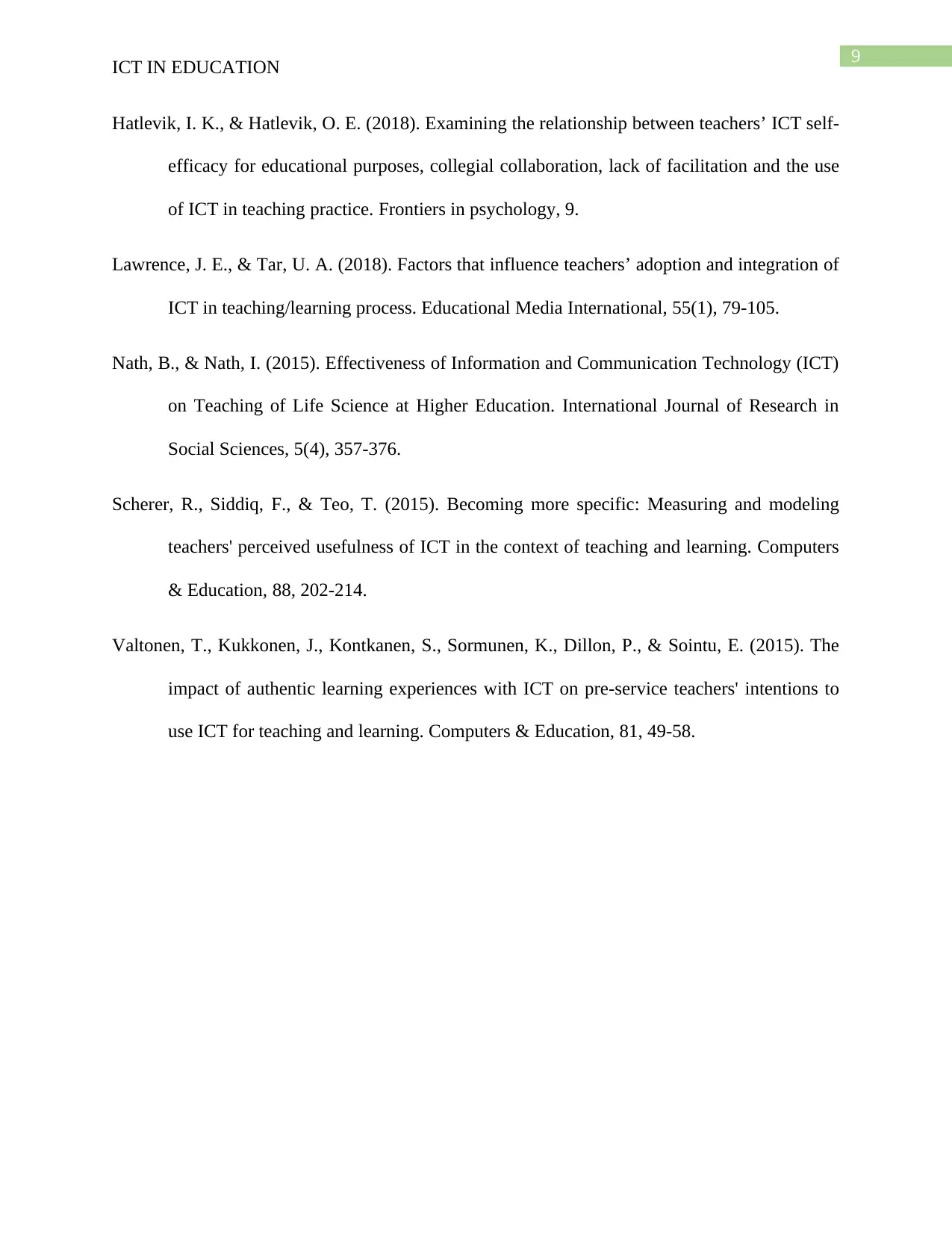
9
ICT IN EDUCATION
Hatlevik, I. K., & Hatlevik, O. E. (2018). Examining the relationship between teachers’ ICT self-
efficacy for educational purposes, collegial collaboration, lack of facilitation and the use
of ICT in teaching practice. Frontiers in psychology, 9.
Lawrence, J. E., & Tar, U. A. (2018). Factors that influence teachers’ adoption and integration of
ICT in teaching/learning process. Educational Media International, 55(1), 79-105.
Nath, B., & Nath, I. (2015). Effectiveness of Information and Communication Technology (ICT)
on Teaching of Life Science at Higher Education. International Journal of Research in
Social Sciences, 5(4), 357-376.
Scherer, R., Siddiq, F., & Teo, T. (2015). Becoming more specific: Measuring and modeling
teachers' perceived usefulness of ICT in the context of teaching and learning. Computers
& Education, 88, 202-214.
Valtonen, T., Kukkonen, J., Kontkanen, S., Sormunen, K., Dillon, P., & Sointu, E. (2015). The
impact of authentic learning experiences with ICT on pre-service teachers' intentions to
use ICT for teaching and learning. Computers & Education, 81, 49-58.
ICT IN EDUCATION
Hatlevik, I. K., & Hatlevik, O. E. (2018). Examining the relationship between teachers’ ICT self-
efficacy for educational purposes, collegial collaboration, lack of facilitation and the use
of ICT in teaching practice. Frontiers in psychology, 9.
Lawrence, J. E., & Tar, U. A. (2018). Factors that influence teachers’ adoption and integration of
ICT in teaching/learning process. Educational Media International, 55(1), 79-105.
Nath, B., & Nath, I. (2015). Effectiveness of Information and Communication Technology (ICT)
on Teaching of Life Science at Higher Education. International Journal of Research in
Social Sciences, 5(4), 357-376.
Scherer, R., Siddiq, F., & Teo, T. (2015). Becoming more specific: Measuring and modeling
teachers' perceived usefulness of ICT in the context of teaching and learning. Computers
& Education, 88, 202-214.
Valtonen, T., Kukkonen, J., Kontkanen, S., Sormunen, K., Dillon, P., & Sointu, E. (2015). The
impact of authentic learning experiences with ICT on pre-service teachers' intentions to
use ICT for teaching and learning. Computers & Education, 81, 49-58.
1 out of 10
Related Documents
Your All-in-One AI-Powered Toolkit for Academic Success.
+13062052269
info@desklib.com
Available 24*7 on WhatsApp / Email
![[object Object]](/_next/static/media/star-bottom.7253800d.svg)
Unlock your academic potential
© 2024 | Zucol Services PVT LTD | All rights reserved.





